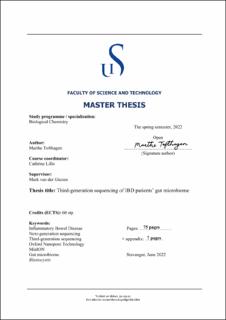| dc.description.abstract | The current opportunities for thorough gut microbiota profiling using next-generation sequencing (NGS) have opened up for a wide range of metagenomic studies. IBD prevalence is increasing in developed and developing countries that are gradually adapting to a more modern lifestyle. Although the specific pathogenesis is unknown, dysbiosis of the intestinal microbiota is widely believed to cause or promote intestinal inflammation. Intestinal microbial compositions in IBD and healthy individuals have been reported in an increasing number of studies using non-cultured 16S rRNA sequencing technologies. Studying intestinal microbes in relation to their ecological niche, such as relationships with gut microbiota, is an essential step toward fine-tuning our clinical and public health understanding of colonization by intestinal microbes. The main goal of this study was to assess the composition of the gut microbiome in patients diagnosed with IBD using next-generation sequencing. Samples from patients diagnosed with ulcerative colitis (UC) or Crohn's disease (CD), included in a clinical trial at Stavanger university hospital (SUS), were used for this study. DNA was extracted using a modified protocol for fecal DNA extraction in combination with Fast DNA stool kit from Qiagen. Library preparation using protocols provided by Oxford Nanopore Technologies (ONT) was done before sequencing with the MinION sequencer. A post-sequencing pipeline for data analysis provided information about taxonomic classification and diversity of the samples. Samples were also sequenced using Illumina MiSeq to establish the prevalence of Blastocystis. The results showed that sequencing with ONTs' MinION provided taxonomic identification down to species level.
The most abundant phyla among the samples were Firmicutes, Bacteroidetes, and Proteobacteria. UC vs. CD was compared at the genus level, showing differences in the abundance of Faecalibacterium, Prevotella, and Roseburia, indicating that dysbiosis may be involved in IBD activity and that there may be differences between patients with CD and UC. A total of 14% of all the samples were Blastocystis positive; the positive samples had a more Prevotella-driven enterotype, while the Blastocystis negative samples had a more Bacteroides- driven enterotype. Although the changed microbial profiles did not exhibit consistent findings across previous studies, a common trait, namely lower bacterial diversity, surfaced in most of the IBD patients. A comparison of Illumina MiSeq and MinION sequencing concluded that there was little difference in the taxonomic resolution between Illumina MiSeq on higher taxonomic levels. | |
